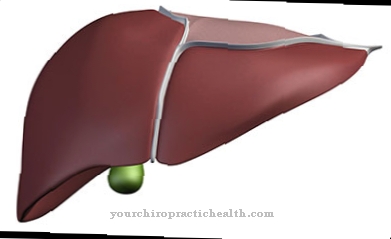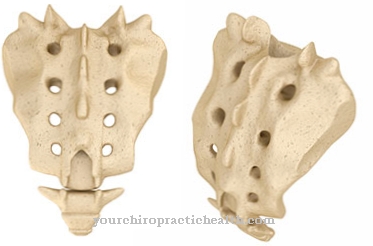The Fibrodysplasia ossificans progressiva (FOP) is a very rare hereditary disease, which is characterized by a progressive ossification of the skeleton. Even the smallest injuries trigger additional bone growth. There is still no causal treatment for this disease.
What is Fibrodysplasia ossificans progressiva?

© wawritto - stock.adobe.com
The term Fibrodysplasia ossificans progressiva already indicates a progressive bone growth. This takes place in phases, whereby new bones from muscle or connective tissue can form even with the smallest trauma. The increasing ossification cannot be stopped.
Only a slowing down of the bone growth is partially possible through drug treatment. Surgical interventions or infusions into the muscle should be avoided as they can induce a new flare of ossification. The disease was first mentioned in 1692 by the French doctor Guy Patin. In 1869 the doctor Ernst Münchmeyer described the syndrome, which was then also called Münchmeyer syndrome was designated.
Further names for Fibrodysplasia ossificans progressiva (FOP) are in addition to Münchmeyer syndrome among others Fibrodysplasia ossificans multiplex progressiva or Myositis ossificans progressiva. FOP is genetic. Their frequency is 1 in 2 million.
The extreme rarity of the disease results from the fact that it is an autosomal dominant mutation. A person affected by FOP usually has no offspring. Therefore, they are almost always new mutations. Around 600 people worldwide are currently known to have Fibrodysplasia ossificans progressiva.
causes
Fibrodysplasia ossificans progressiva is caused by a genetic defect in a gene on the long arm of chromosome 2. This gene encodes the so-called ACVR1 receptor. The ACVR1 receptor is responsible for normal skeletal development and the growth of connective and supporting tissue. It is mainly found on the cells of the striated skeletal muscles and the connective and cartilage tissue.
The corresponding mutation can lead to permanent activation of the receptor. In the course of growth processes within the framework of normal growth and in the event of injuries, it constantly sends out the signal for the formation of bone cells from muscle or connective tissue cells. Usually this signal is only switched on during skeletal formation during embryogenesis.
However, the genetic defect prevents the signal from being switched off after the fetus has developed. If it cannot be turned off, persistent ossification or episodes of ossification takes place. The mutation on this gene is inherited in an autosomal dominant manner.
The offspring of an affected person would have a 50 percent chance of suffering from this disease. However, since people with FOP almost never have offspring, the cases observed are usually new mutations.
You can find your medication here
➔ Medicines for painSymptoms, ailments & signs
Fibrodysplasia ossificans progressiva shows up already after birth through a twisting and shortening of the big toes. In 50 percent of the cases, the thumbs are also shortened. More than 90 percent of the cervical vertebrae show malformations. In the first few years of life, the mobility of the cervical spine is restricted.
In the further course of development, ossification takes place from top to bottom. After the cervical spine has solidified, the ossification process continues to the extremities and trunk. The disease progresses in attacks that are associated with inflammatory processes. Each episode begins with swelling and heating of the corresponding part of the body.
This swelling is very painful. Only after new bones have formed from muscle tissue in the affected area does the thrust stop and the pain cease. Even with the slightest injury to muscle tissue, ossification occurs. Falls, operations or injections into the muscle tissue are often the trigger for a disease flare-up.
However, the disease can progress in bouts or continuously. Continuous bone growth can occur before and during puberty, because the body grows more rapidly during this time. After puberty, those affected are often dependent on wheelchairs, as almost all joints are stiffened. The limited mobility of the chest can cause respiratory problems. There is a risk of life-threatening pneumonia.
diagnosis
A suspected diagnosis of Fibrodysplasia ossificans progressiva can already be made through the typical shortening and twisting of the big toes of the newborn. A positive genetic test then confirms the diagnosis.
Complications
In Fibrodysplasia ossificans progressiva there are considerable complications in which the person's body ossifies. This process occurs even with very light and minor injuries, in which bone growth is directly stimulated. Most of the time, those affected have suffered from the disease since birth, which is presented by greatly shortened thumbs. The cervical vertebrae are also affected by malformations.
These finally solidify in the first few years of life, so that the ossification of the body continues to progress in the lower area. Most often, severe pain and swelling occur during the process of ossification. These disappear as soon as this is completed.The relapses are mainly triggered by minor injuries to the muscle tissue, so that the patient is extremely restricted in his movements and in his everyday life.
Often there are breathing problems and inflammation in the lungs. Unfortunately, it is not possible to treat the cause of Fibrodysplasia ossificans progressiva. The main aim of the treatment is to delay the course of the disease. Surgical removal is also not possible. The life expectancy is significantly shortened by the disease and the quality of life drops sharply.
When should you go to the doctor?
If clearly recognizable anomalies of the cervical spine or toes can be found after the birth of the child, these should be discussed with a doctor. Stiffening of the joints or bones should be examined and treated immediately. If there are any other abnormalities in the skeletal system during the growth and development process of children, a doctor should be consulted.
If there are any irregularities that show up in comparison to physical changes in their peers, it is advisable to consult a doctor. If parents or legal guardians can determine ossification or twisting in the child's bone structure, these should be clarified by a doctor as soon as possible.
Shortening of the fingers or thumb is considered unusual and should be presented to a doctor. A doctor should be consulted in the case of incomprehensible swelling or bulging of the skin. If the changes in the bone structure increase or if they spread to other parts of the body, a doctor's visit is necessary.
If the child complains of pain, if it shows behavioral problems or if it loses the joy of living, these are signs of serious complaints. A doctor should be consulted if aggressive behavior persists for several days, repeated refusals to eat or unusual indifference. If there are restrictions in movement or breathing problems, a doctor's visit is necessary.
Doctors & therapists in your area
Treatment & Therapy
Fibrodysplasia ossificans progressiva cannot yet be treated causally. Only symptomatic treatments are possible. The course of the disease is not stopped, but at least delayed by drug treatment. In drug therapy, the focus is initially on treating pain in the event of an attack.
Anti-inflammatory drugs such as corticosteroids and non-steroidal anti-inflammatory drugs are used. Research is still ongoing into a causal therapy option with antibodies and signal transmission inhibitors against the ACVR1 receptor. However, this therapy is not yet ready for use. The additional bones, however, must not be surgically removed, because this would result in a new flare-up of the disease with a much stronger ossification.
Outlook & forecast
The prognosis for Fibrodysplasia ossificans progressiva is negative. The progressive ossification of connective and supporting tissue means that the condition continues to deteriorate. In addition, there are so far only a few promising treatment approaches. According to current medical knowledge, the disease cannot be cured.
Since Fibrodysplasia ossificans progressiva occurs in bursts, research is trying to at least alleviate accompanying inflammatory symptoms. Drug research should ensure that the progression of the disease can be countered more in the future. Genetic research also plays a key role in this.
Unfortunately, the disease is so rare that only about 700 cases are known worldwide. It is therefore not to be expected that there will be sufficient research funding in the future. For those affected, the prospects of alleviating the consequences of the disease remain poor. Above all, injuries of all kinds must be prevented, as these lead to new bone formation.
This means an enormous need for protection and a very restricted life, especially for the children affected. The increasing ossification, which progresses from top to bottom, at some point also restricts lung function. In their mid-twenties, many people are already in a wheelchair. Adults have an average life expectancy of 40 years. The more the chest becomes ossified, the harder it is to breathe. In the end, those affected can no longer be helped.
You can find your medication here
➔ Medicines for painprevention
Since Fibrodysplasia ossificans progressiva is usually a new mutation, prevention is not possible. Sick people should, however, use all possibilities to delay the ossification process. This includes the absolute avoidance of injuries.
Even bruises as well as overstretching or overstraining the muscles can trigger a disease flare-up. Injections into the muscle should be avoided. Operations can only be carried out in extreme emergencies. Cortisone treatment should be used for fresh injuries or relapses.
Aftercare
In the case of Fibrodysplasia ossificans progressiva, the person affected usually does not have any special follow-up measures available. Since this disease is a genetic disease, the options for treatment are severely limited, so that only purely symptomatic treatment can be given. If the patient wishes to have children, genetic counseling can also be carried out so that the disease is not passed on to the descendants.
The focus is on the early detection of Fibrodysplasia ossificans progressiva. Treatment itself is carried out with the help of medication. The person affected should ensure that the medication is taken correctly and regularly and also follow the doctor's instructions. A doctor should always be contacted in cases of doubt or if anything is unclear.
However, it is not uncommon for surgical interventions to be necessary to alleviate the symptoms of Fibrodysplasia ossificans progressiva. After such an operation, the patient should always rest and take care of his body. Exertion or other stressful activities and activities should be avoided in any case. Whether Fibrodysplasia ossificans progressiva will reduce the life expectancy of the person affected cannot generally be predicted.
You can do that yourself
In the case of Fibrodysplasia ossificans progressiva, the person affected generally has no options for self-help. The disease can only be treated symptomatically, so that causal therapy is not possible.
As the symptoms and symptoms of this disease are aggravated by injuries to the skeleton, these injuries must be prevented at all costs. For this reason, those affected should be careful with sports or activities.
In most cases, other complaints are treated with the help of medication and surgery. If the person concerned is dependent on painkillers, they should not be taken for a longer period of time. In the case of self-injecting injections, care should be taken not to inject them directly into the muscle. Caution should also be observed when treating with cortisone; accompanying doctor visits and regular intake are mandatory.
Children should be informed about the consequences and limitations of Fibrodysplasia ossificans progressiva in order to prevent any psychological problems that may arise. Meeting other sick people can also have a positive effect on the child's development.




























.jpg)